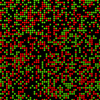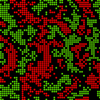Remote Ready Biology Learning Activities has 50 remote-ready activities, which work for either your classroom or remote teaching.
Serendip is an independent site partnering with faculty at multiple colleges and universities around the world. Happy exploring!

| Thinking About Segregation and Integration | 
|
| Introduction | Implications | Exploration Tips | An Advanced Model | References |
|
|
So, did you see an integrated distribution turn into a segregated one? Were you surprised? Schelling certainly was, and most people are when they see the model for the first time. What it indicates is that a VERY mild preference for having similar people around one is enough in this situation to result in segregation. Notice that a 50% preference means that everyone would in fact be content in an integrated environment, but because unhappy people move randomly, a segregated environment results nonetheless.
Does that ALWAYS happen, or does it depend on the starting distribution? Try it again and see. As many times as you need to to get an answer that satisfies you.
What happens if you make the preference for similarity even less? Try a range of values (be sure to do each several times) and plot the resulting percent similar as a function of preference. Add some preference values above 50% and plot those too. Is it a simple relationship? Are you surprised? Why is the relationship the way it is?
It looks like its surprisingly hard to get an integrated environment by reducing peoples' preferences to be around people like themselves. Frustrating perhaps, if one thinks integration is a good thing. Is there any OTHER way to get integration? Try "setup with a segregated distribution" and changing preference to "prefers difference" (click and hold on the red triangle and select appropriately from the drop-down menu). Is that interesting? Try varying "strength-of-preference" with those settings.
When you've got some feeling for how the model behaves for a given population size/density, you can try varying that and see how it affects the conclusions you might reach. And if all this makes you wonder about some other things that might influence what happens, you can go on to the Advanced Model.
Wilensky, U. (1998). NetLogo Segregation model. http://ccl.northwestern.edu/netlogo/models/Segregation. Center for Connected Learning and Computer-Based Modeling, Northwestern University, Evanston, IL.
created with NetLogo
view/download model file: SerendipSegregation.nlogo